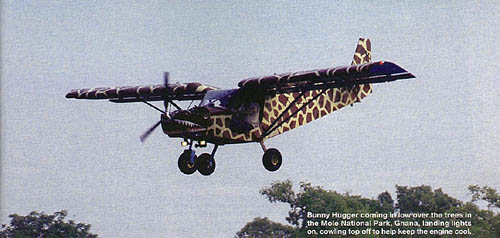
ZENITH AIRCRAFT AT WORK AROUND THE WORLD
'Bunny Hugger in
Harmattan'
STOL CH 701: African Anti-Poaching Patrol
By "Hannibal," reprinted from EAA Experimenter, January 1998
Poaching gangs have packed up and moved on, vacating Mole National Park in northwest Ghana in a big hurry. They're afraid of getting caught by the new Flying Tigers piloting their intrepid little "Bunny Hugger."
The Bunny Hugger is a STOL CH 701 aircraft, whose 70 modifications were featured in the March 1997 issue of EXPERIMENTER. Since then, the rugged little two seater has been flying anti-poaching patrols on a regular basis under some highly irregular conditions in the African bush. And, it's standing up to the test like a champ. Of course, a few more mods were made to help the sprightly machine adapt to the tropics. But that's what experimenting is all about - fiddling around with this and that to make something better.
The biggest problem encountered by the new Flying Tigers was the Harmattan. That's what Ghanaians call an enormous mass of air which sweeps up all the loose dust in the Sahara Desert and wafts it off to West Africa. Think of it as a big brown mist or fog that can clog your air filters in a hurry. It can also cut visibility down to about 1,000 yards or so. But since there's no abrupt topography, nor colossal power lines, grandiose skyscrapers or monumental antennas out in this part of the African bush, the little Zenair can throttle back to a nice slow cruise speed and chug along with very little risk of banging into anything, except more dust.
| Elephants in the mist. Or, more precisely, elephants in the Harmattan - that notorious air filter clogging, visibility reducing enormous cloud of Sahara dust. | 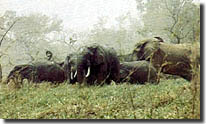 |
Heat was another problem. One day the thermometer indicated 37 degrees Centigrade. A few clicks on the ever-handy asa CX-1 Pathfinder reveals that equals precisely 98.6 old fashioned Fahrenheit degrees. Could have been worse. Could have been 100. The heat's first victim was the Bunny Hugger's Engine Information System (EIS) produced by Grand Rapids Technologies, Inc. The EIS is a wonderful, compact instrument with oodles of functions - but when the unit temperature gets up to 50 degrees C. (122 F.) the liquid crystal screen goes bazonk. And the unit temperature did indeed get up to 50 degrees C. Losing the digital tachometer, cylinder head temperature, oil temperature and pressure, and a whole bunch of other readings all at once - can stimulate the adrenal cortex!
Fortunately, Itzhak "Magic" Glaser, the project's chief mechanic provided a quick fix by clipping a few snips of aluminum, cutting a wee bit of hose and slipping it down just in front of the wind-shield to conduct a blast of cooling (?) dusty air to the EIS unit any time the prop was spinning. Worked like a charm. The functioning EIS unit provided Bunny Hugger pilots with just the information they really were not enthusiastic to see: Warmish engine temperatures for the Rotax 912. But that was also fixed quickly and effectively by removing the top of the cowling, and securing the lower part with a few wraps of safety wire. The stream-line profile of the cowling suffered a little bit - but then, the Zenair CH-701 STOL does not have a long string of beauty contest awards.
| Mole National Park Senior Wildlife Officer Cletus Nateg and Bill Clark just after landing following an anti-poaching patrol in Mole. Cletus is a new pilot so we did dual patrols to help build his confidence in his piloting abilities and experience. | 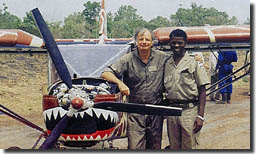 |
More importantly, temperatures inside the exposed engine cooled to within perfect operating limits. Accra's Kotoka International main Thus, a little EIS cooling pipe, and removal of the upper cowling were all that was needed to keep Bunny Hugger up and flying anti- poaching patrols over the remote African wilderness - until Kelli showed up. Group Captain (Colonel) Sakara Kelli retired from the Ghana Air Force about one year ago and was just getting comfortable in his senior citizen's rocking chair when he was summoned to Accra, the capital. It seems that Ghana's President, J.J. Rawlings, likes both elephants and airplanes, so it was only natural that he had taken a shine to the Flying Tigers project. The President even flew Bunny Hugger himself and found great joy in piloting this aluminum cricket down the entire length of Accra’s Kotoka International main Runway 21. The distance from one end of 21 to the other is so long for the Zenair STOL that the President was advised to file a flight plan before departure.
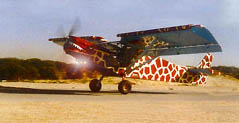
President Rawlings liked the Zenair so much that he wanted to assure her keys were entrusted to someone absolutely reliable. Thus Kelli was called out of retirement. Kelli's problem, however, was that his 30 years in the Ghana Air Force gave him lots of experience with heavy metal, such as the Aermacchi 326K, which is something like a cross between an old A-4 Skyhawk and a Ferrari. Those big ground support jets don't handle exactly like a 960-pound (gross) Zenair 701. More precisely, they don’t behave the same in the flare.
It is indeed possible to dismount a Zenair nosewheel by the headlights of a pickup truck. But it isn’t easy. If the nosewheel strut went much higher it could be pressed to double duty as an exhaust smokestack. Getting that strut out to weld a crack near the bottom end involved the skinning of a few knuckles, the swearing of a few expletives, and the removal of the muffler and assorted do-dads. Condor Aviation, of Rishon Lezion, Israel, is now building a nose strut repair mod for any Zenair owners who experience similar difficulties. With the new modification, a crack at the lower end of the strut doesn't require a major disassembly job - just removal of the lower end and slipping a sleeve fitting over the strut.
| Changing the nosewheel strut by truck lights in the middle of the Mole National Park. Getting the landing gear flare just right was a little tricky for a new student. | 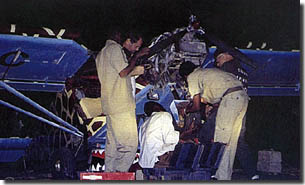 |
A late night visit to an arc welding shop consumed so much electricity all the refrigeration units at Park Headquarters went on the fritz. Thus, it became impossible to find even English-warm beer anywhere. Accordingly, the crew imbibed sudzy libations with temperatures better suited for English tea. just as well. Nobody wanted key personnel to get too enamored with the "Beer that made Larabanga Famous" - there was a dawn anti-poaching patrol to fly the next day.
The project continued, and the Zenair performed superbly. The Bunny Hugger turned out to be a bush plane par excellence. Basic maintenance, augmented by more frequent cleaning of the air filters and spark plugs, kept the aircraft flying without any difficulty. The air filters were cleaned more often because of all the harmattan dust in the air. The plugs were cleaned more often because dust on the air filters tended to choke the air intake slightly, producing an excessively rich mixture. But, these were minor inconveniences caused by the weather.
The Bunny Hugger worked hard. The first take off of the day usually occurred shortly after sunrise. The final landing usually coincided with sunset. In between, there were hundreds of miles of anti-poaching patrols off to remote corners of the 4,840 square kilometer national park. There was also some monitoring of wildelife populations, with Garmin-90 GPS fixes being used to provide precise data on the locations of elephants, buffalo, antelope and baboons. Also, there were "courtesy calls" to villages such as Larabanga and Murugu, which are well known as poacher havens. The courtesy calls were fly-overs, just to remind the poachers that the risks of getting caught have been increased.
And, of course, there were instructional flights - the hardest type of flying for nearly any airplane. David Wiernik (an Israeli ATP and CFII) served as chief instructor and worked at getting the Ghanaians to a point where they could accept the Bunny Hugger and take care of all the piloting and maintenance themselves. Kelli soon got his Zenair flare down pat - even from the right seat. Today, he is coaching Ghana Department of Wildlife senior officers (and newly licensed pilots) Iddi Kasim and Cletus Nateg through their first patrols over Mole National Park.
| Bunny Hugger STOL CH 701 on take-off. | 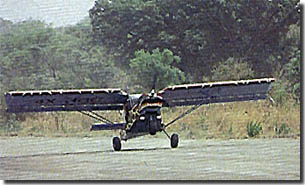 |
When the new Flying Tigers team left Ghana, the National Wildlife Department had full control of the project and regular anti-poaching patrols had been started. A system for delivering spare parts has been established. The project is now a permanent element of Mole National Park's wildlife protection system.
Meanwhile, the Flying Tigers' second Zenair CH-701 STOL has been received in Israel, where it is undergoing five or six dozen modifications, plus a whole bunch of hours of test flying. One of the major policy issues now being debated is what color scheme should be applied to the current layer of undercoat. Bunny Hugger’s reticulated giraffe design is appealing to many people, and a new tradition may have been established. However, there are vocal minorities pulling for skunk stripes, parrot plumage and even cheetah spots.
Their third Zenair is on order and should have made landfall on the eastern Mediterranean by now. That will undoubtedly precipitate another debate on what color paint to buy.
| Formerly retired Group Captain (Colonel) Sakara Kelli and Israeli CFII and ATP David Wiernik. Kelli did some right seat work in the Zenair, which is interesting because the stick is centrally located, requiring Kelli to use his left hand. Kelli is now instructing the recently trained Ghanaian wildlife officer/pilots through that sensitive "low time" period after gaining the license but before gaining much experience. | 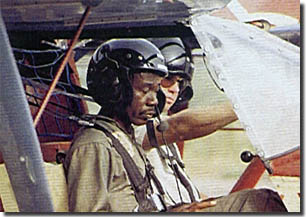 |
The Flying Tigers' next operations were scheduled for late 1997 - probably in Senegal and Mali although there are several other candidates having dibs in East Africa and South Asia. This time, two aircraft will be on patrol. Poachers beware!
If you would like more information about the use of the STOL CH 701 in Africa, contact Bill Clark, Friends of Animals, PO Box 7274, Jerusalem 91072 Israel.
- By "Hannibal," reprinted from EAA Experimenter, January 1998, Pages 43 - 45.
For additional information:
- Related Story: "Flying Tigers"
- STOL CH 701: Videos | Photo Galleries
- EAA EXPERIMENTER Magazine: March
1997
"Evolution of a Bunny Hugger" story, pages 43-45.
| March 2007 Update: | |
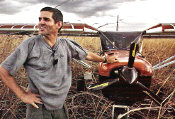 |
National
Geographic magazine used a STOL CH 701 in Chad's Zakouma National
Park (Africa) to photograph massive elephant herd movements, featured in
the March 2007 issue of the magazine.
|
[Back]
NOTE: This article represents the viewpoints of the author, and not necessarily those of Zenith Aircraft Company.
|
ZODIAC Series |
© Zenith Aircraft Company
2013-09-30
|
Zenith Aircraft
Company |
